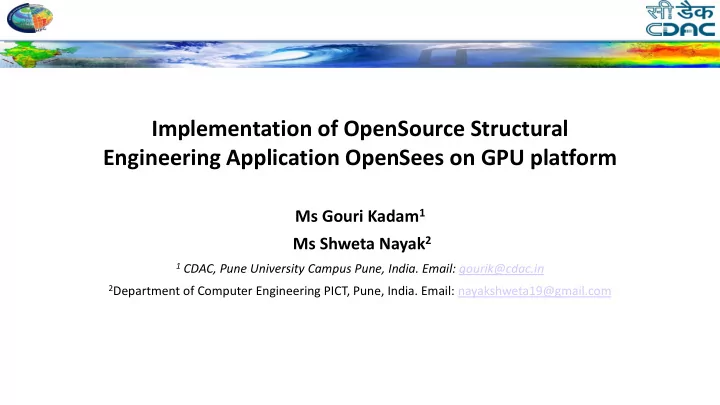

Implementation of OpenSource Structural Engineering Application OpenSees on GPU platform Ms Gouri Kadam 1 Ms Shweta Nayak 2 1 CDAC, Pune University Campus Pune, India. Email: gourik@cdac.in 2 Department of Computer Engineering PICT, Pune, India. Email: nayakshweta19@gmail.com
INDEX Introduction Why GPU Methodology Case Study Results and Discussion Future Scope 7-Dec-17
About OpenSees The software framework OpenSees (Open System for Earthquake Engineering Simulation) provides a platform for structural and geotechnical engineers. OpenSees has more than 160 element types , 220 material types, 15 solution algorithms and 30 solver types Static Problems : Deformation analyses (1D, 2D, or 3D) Consolidation problems Soil-structure interaction problems Shallow foundations (e.g. bearing capacity, deformation) Pile foundations (e.g. vertical and lateral capacity) Dynamic (earthquake problems): Free-field analysis Liquefaction-induced problems Soil structure interaction problems 7-Dec-17
Objective of the Study For earthquake simulation of large scale structural and geotechnical system parallel computation is the only option. Algebraic libraries developed very rapidly for solving very large number mathematical problems using efficient parallel algorithms. Accelerators such as GPUs are very efficient in handling such problems. Available GPU enabled version of OpenSees provided by Xinzheng Lu, Linlin Xie (Tsinghua University, China) uses CulaS4 and CulaS5, which use the Cula library. Also currently supported on window’s platform GPU computing is emerging as an alternative to CPUs for throughput oriented applications because of their Number of cores embedded on the same chip User friendly changes in input scripts of the application and from developers prospective great expertise in CUDA programming is not a limitation. Source: https://goo.gl/images/Sr5sKd 7-Dec-17
Why CUSP Libraries Considered Hardware Used Software Used Library Type • One of the server of CAE group at CDAC OpenSees 2.4 and (cfd-WS2) with following configuration above used for testing and simulation. CULA Licensed • gcc: 4.5.0 CUSP OpenSource • CPU : 20 x Intel(R) Xeon(R) • make: 2.8.11 CPU E5-2650 v3 @ 2.30 • tcl8.5 cuSPARSE Closed Source GHZ • tcl8.5-dev • PETSc OpenSource GPU : 2 x NVIDIA GK104GL • g++ :4.5.0 - Quadro K4200 • gfortran • RAM : 32 GB • CUDA 7.0 and higher • OS : CentOS 6.7 • CuSP provides a flexible, high-level interface for manipulating • CUSP library sparse matrices and solving sparse linear systems. • It is the best suited library as it will give the interface for C and C++ classes. • Most important, it is open Source and easy in new algorithm implementation compared to others. 7-Dec-17
Methodology Basic Processing Flow Example of Processing Flowchart Source : https://commons.wikimedia.org/wiki/File:CUDA_processing_flow_(En).PNG 7-Dec-17
Case Study and Results Modifications in Input Script Input Script (CPU) GPU enabled Script integrator LoadControl 1.0 integrator LoadControl 1.0 algorithm Linear algorithm Linear numberer RCM numberer RCM constraints Plain constraints Plain system SparseGeneral -piv system CuSP analysis Static analysis Static analyze 1 analyze 1 GPU and CPU Performance comparison 7-Dec-17
Availability in Public Domain 7-Dec-17
Future Scope Multi-GPU Implementation : All above mentioned work is done for single GPU implementation. By adding the necessary support of thrust library to CuSP or by rewriting dynamic library using multi- GPU supporting CUDA enabled libraries, implementation of other accelerators mean for heterogeneous/ hybrid architecture more speed up can be achieved. Only concern will be the increase in complexity from users perspective need to be considered. Adding support for OpenCL: The provided implementation has the limitation that it can only be used with NVIDIA GPUs. Implementing support for platform independent GPU computing APIs, such as OpenCL, would therefore make the implementation accessible to more users. 7-Dec-17
7-Dec-17
Recommend
More recommend